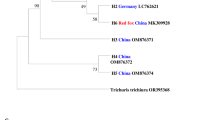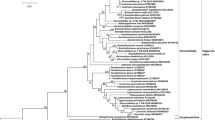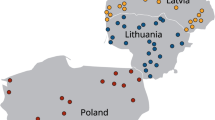Abstract
Knowledge of parasitic infections to which fauna was exposed in the past provides information on the geographical origin of some parasites, on the possible dispersal routes and for archaeological fauna on the potential zoonotic risk that human and animal populations could be exposed. The aim of the present study was to examine the gastrointestinal parasite present in camelid coprolites collected from the archaeological site Cerro Casa de Piedra, cave 7 (CCP7), Patagonia, Argentina. Coprolites were collected from different stratified sequences dating from the Pleistocene-Holocene transition to the late Holocene. Paleoparasitological examination revealed the presence of eggs of Trichostrongylidae attributed to Lamanema chavezi or Nematodirus lamae, eggs of three unidentified capillariids, Strongylus-type eggs and oocysts of Eimeria macusaniensis. These parasites affected camelids living in the studied area since the Pleistocene-Holocene transition, about 10,000 years ago. Gastrointestinal parasite fauna of patagonian camelids did not vary significatively from Pleistocene-Holocene transition to late Holocene, although environmental conditions fluctuated greatly throughout this period, as indicative of the strength and the stability of these associations over time. In this study, the zoonotic and biogeography importance of parasites of camelids are also discussed.



Similar content being viewed by others
References
Acha PN, Szyfres B (1989) Zoonosis y enfermedades transmisibles comunes al hombre y a los animales. Organización Panamericana de la Salud Washington
Aschero CA (1996) El área Río Belgrano-Lago Posadas (Santa Cruz): problemas y estado de problemas. In: Gómez Otero J (ed) Arqueología: Solo Patagonia. CENPAT, Puerto Madryn, pp 17–26
Becklund WW (1963) Lamanema chavezi gen., sp. n. and Nematodirus lamae sp. n. (Nematoda: Trichostrongylidae) from the Alpaca, Lama pacos, and the Vicuna, Vicugna vicugna, in Peru. J Parasitol 49:1023–1027
Beldoménico PM, Uhart M, Bono MF, Marull C, Baldi R, Peralta JL (2003) Internal parasites of free-ranging guanacos from Patagonia. Vet Parasitol 118:71–77
Botero D, Restrepo M (2003) Parasitosis humanas: Incluye animales venenosos y ponzoñosos. Corporación para Investigaciones Biológicas, Medellín
Callen EO, Cameron TWM (1960) A prehistoric diet revealed in coprolites. New Sci 8:35–40
Civalero MT, Aschero C (2003) Early occupations at Cerro Casa de Piedra 7, Santa Cruz Province, Patagonia, Argentina. In: Miotti L, Salemme M, Flegenheimer N (eds) Ancient evidence for Paleo South Americans. From where the south winds blow. Texas A&M University, College Station, pp 141–147
De Nigris ME (2004) El consumo en grupos cazadores recolectores: un ejemplo zooarqeuológico de Patagonia Meridional. Sociedad Argentina de Antropología, Argentina, Buenos Aires. ISBN 987-20674-5-7
Dittmar K, Teegen WR (2003) The presence of Fasciola hepatica (liver fluke) in human and cattle from a 4500 years old archaeological site in the Saale-Unstrut Valley, Germany. Mem Inst Oswaldo Cruz 98:141–144
Fugassa MH (2007) Camélidos, parásitos y ocupaciones humanas: registros paleoparasitológicos en CCP7 (P. N. Perito Moreno, Santa Cruz, Argentina). Intersecciones Antro 8:265–269
Fugassa MH, Sardella NH, Taglioretti V, Reinhard K, Araújo A (2008) Morphometric variability in oocysts of Eimeria macusaniensis (Guerrero et al. 1967) in archaeological samples from the Holocene of Patagonia, Argentina. J Parasitol 94:1418–1420
Karesh W, Uhart M, Dierenfeld F, Braselton W, Torres A, House C, Puche H, Cook R (1998) Health evaluation of free-ranging guanaco (Lama guanicoe). J Zoo Wildl Med 29:134–141
Leguía GP (1999) Enfermedades parasitarias de camélidos sudamericanos. Ed De Mar Lima, Perú
Leguía GP, Casas EA, Wheeler J (1995) Parasitismo en camélidos prehispánicos. Parasitol Día 19:435
Loirelle O, Bouchet F (2003) Evolution of Ascaris in human and pigs: a multi-disciplinary approach. Mem Inst Oswaldo Cruz 98:39–46
Lutz A (1919) Schistosoma mansoni e a schistosomatose segundo observaçoes feitas no Brasil. Mem Inst Oswaldo Cruz 11:121–155
Mancini MV (1998) Vegetational changes during the Holocene in Extra-Andean Patagonia, Santa Cruz Province, Argentina. Palaeogeogr Palaeoclimatol 138:207–219
Miotti L, Salemme M (1999) Biodiversity, taxonomic richness and specialist-generalist during Late Pleistocene/Early Holocene times in Pampa and Patagonia (Argentina, Southern South America). Quat Int 53:53–68
Moravec F (1982) Proposal of a new systematic arrangement of nematodes of the family Capillariidae. Folia Parasitol 29:119–132
Moravec F (2000) Review of capillariid and trichosomoidid nematodes from mammals in the Czech Republic and the Slovak Republic. Acta Soci Zool Bohem 64:271–304
Moravec F (2001) Trichinelloid nematodes. Parasitic in cold-blooded vertebrates. Academia, Praha
Navone GT, Merino ML (1989) Contribución al conocimiento de la fauna endoparasitaria de Lama guanicoe Muller, 1776, de Península Mitre, Tierra del Fuego, Argentina. Bol Chil Parasitol 44:46–51
Pestechian N, Kalani H, Faridnia R, Yousefi H (2014) Zoonotic gastrointestinal nematodes (Trichostrongylidae) from sheep and goat in Isfahan, Iran. Acta Sci Vet 42:1–6
Poole JB (1956) Reaction to temperature by infective larvae of Nematodirus filicollis, Trichostrongylidae (Nematoda). Can J Comp Med 20:169–172
Robles MR (2008) Nematodes Oxyuridae, Trichuridae y Capillariidae en roedores Akodontini (Cricetidae, Sigmodontinae) de la Cuenca del Plata (Argentina): su importancia en la interpretación en las relaciones parásito-hospedador-ambiente. PhD Thesis, Universidad Nacional de La Plata, Facultad de Ciencias Naturales y Museo, Argentina 269 pp
Santoro C, Dorsey Vinton SH, Reinhard KJ (2003) Inca expansion and parasitism in the Lluta Valley: preliminary data. Mem Inst Oswaldo Cruz 98:161–163
Soulsby EJL (1987) Helmintos, artrópodos y protozoos de los animales domésticos. Ed Interamericana, México
Taglioretti V, Sardella NH, Fugassa MH (2014a) Morphometric analysis of modern faeces as a tool to identify artiodactyls’ coprolites. Quat Int 352:64–67
Taglioretti V, Fugassa MH, Beltrme MO, Sardella NH (2014b) Biometric identification of capillariid eggs from archaeological sites in Patagonia. J Helminthol 88:196–202
Wheeler JC (1995) Evolution and present situation of the South American Camelidae. Biol J Linn Soc 54:271–295
Acknowledgments
Our most grateful thanks to the archaeologist Maria Teresa Civalero and Carlos Alberto Aschero for bringing us the archaeological samples.
This work was supported by the Universidad Nacional de Mar del Plata (UNMDP), Argentina (EXA 680/14), the Consejo Nacional de Investigaciones Científicas y Tecno-lógicas (CONICET), Argentina (PIP 090) and FONCyT (PICT 2316).
Author information
Authors and Affiliations
Corresponding author
Rights and permissions
About this article
Cite this article
Taglioretti, V., Fugassa, M.H. & Sardella, N.H. Parasitic diversity found in coprolites of camelids during the Holocene. Parasitol Res 114, 2459–2464 (2015). https://doi.org/10.1007/s00436-015-4442-y
Received:
Accepted:
Published:
Issue Date:
DOI: https://doi.org/10.1007/s00436-015-4442-y




